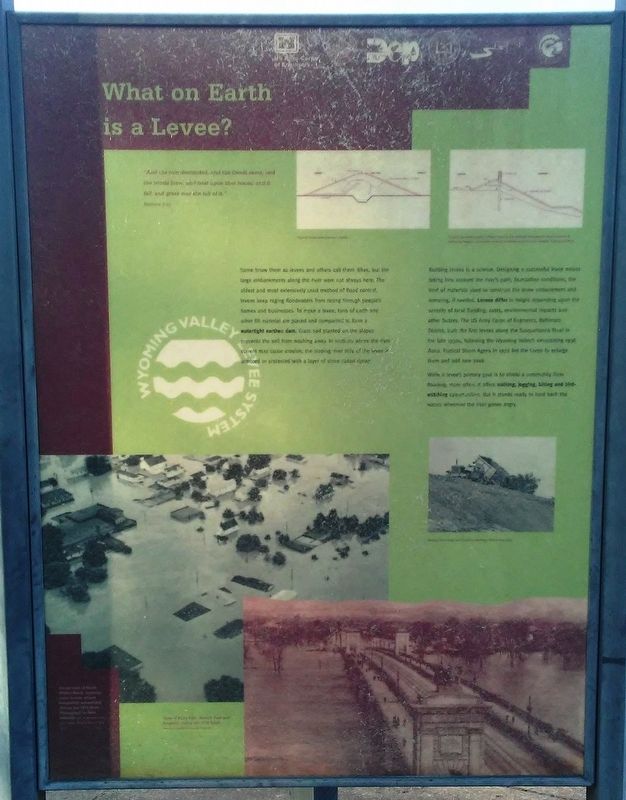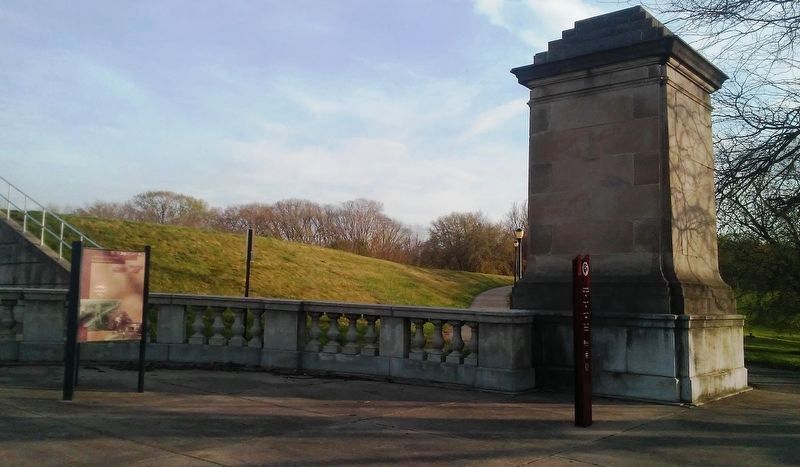What on Earth is a Levee?
Wyoming Valley Levee System
"And the rain descended, and the floods came, and the winds blew, and beat upon that house, and it fell; and great was the fall of it."
Matthew 7:27
Some know them as levees and others call them dikes, but the large embankments along the river were not always here. The oldest and most extensively used method of flood control, levees keep raging floodwaters from racing through people's homes and businesses. To make a levee, tons of earth and other fill material are placed and compacted to form a watertight earthen dam. Grass sod planted on the slopes prevents the soil from washing away. In sections where the river current may cause erosion, the sloping river side of the levee is armored or protected with a layer of stone called riprap.
Building levees is a science. Designing a successful levee means taking into account the river's path, foundation conditions, the kind of materials used to construct the levee embankment and armoring, if needed. Levees differ in height depending upon the severity of local flooding, costs, environmental impacts and other factors. The US Army Corps of Engineers, Baltimore District, built the first levees along the Susquehanna River in the late 1930s, following the Wyoming Valley's devastating 1936 flood. Tropical Storm Agnes in 1972 led the Corps to enlarge them and add
new ones.While a levee's primary goal is to shield a community from flooding, more often, it offers walking, jogging, biking and bird-watching opportunities. But it stands ready to hold back the waters whenever the river grows angry.
[Illustrations, from top to bottom, read]
• Typical levee embankment profile
• Typical floodwall profile. Where there is not enough land area to build a levee of sufficient height a concrete or steel floodwall provides the needed flood protection.
• Placing fill to build the Swoyersville-Forty Fort levee, 1953.
• Aerial view of South Wilkes-Barre showing some homes almost completely submerged during the 1972 flood. Photo by Sam Salutsky.
• View of Kirby Park, Nesbitt Park and Kingston during the 1936 flood.
Erected by Delaware & Lehigh National Heritage Corridor and Others.
Topics. This historical marker is listed in these topic lists: Charity & Public Work • Disasters • Man-Made Features • Waterways & Vessels. A significant historical year for this entry is 1936.
Location. 41° 15.075′ N, 75° 53.247′ W. Marker is in Kingston, Pennsylvania, in Luzerne County. Marker is at the intersection of Market Street and the west approach to the Market Street Bridge, on the right when traveling east on Market
Other nearby markers. At least 8 other markers are within walking distance of this marker. A Formal Promenade Across the River (here, next to this marker); Trailing Along (here, next to this marker); a different marker also named Trailing Along (within shouting distance of this marker); Bridging Two Cities (within shouting distance of this marker); a different marker also named What on Earth is a Levee? (within shouting distance of this marker); War Memorial (within shouting distance of this marker); Wilkes-Barre (about 600 feet away, measured in a direct line); 109th Field Artillery Battalion Memorial (approx. ¼ mile away). Touch for a list and map of all markers in Kingston.
More about this marker. An identical marker is northeast across Market Street.
Also see . . .
1. Levee. Wikipedia entry (Submitted on November 3, 2023, by Larry Gertner of New York, New York.)
2. Levee system built after destruction from Agnes to protect Wyoming Valley. WNEP16 News website entry (2022) (Submitted on November 3, 2023, by Larry Gertner of New York, New York.)
3. Hurricane Agnes documentary on WBRE-TV (1992). YouTube video: 58m 16s (Submitted on May 6, 2018, by William Fischer, Jr. of Scranton, Pennsylvania.)
4. Delaware & Lehigh National Heritage Corridor. Website homepage (Submitted on May 6, 2018, by William Fischer, Jr. of Scranton, Pennsylvania.)
Credits. This page was last revised on November 3, 2023. It was originally submitted on May 6, 2018, by William Fischer, Jr. of Scranton, Pennsylvania. This page has been viewed 115 times since then and 6 times this year. Photos: 1, 2. submitted on May 6, 2018, by William Fischer, Jr. of Scranton, Pennsylvania.

